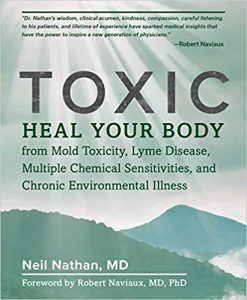Psychiatry
Psychiatric Symptoms, Mold and Environmental Toxicity
Acquired environmental illness may be the future of psychiatry.
Posted January 4, 2019

Environmentally acquired illnesses (EAI) are often not recognized by conventional medicine. Patients run from one doctor to another and no one can help them. The usual lab studies often reveal nothing treatable because their health care providers are not testing for the right things. When all the studies come back normal, a patient may be told that her somatic concerns are an expression of her anxiety or depression, and that she should see a psychiatrist. If the underlying cause of these symptoms is an environmentally acquired illness, diagnosis is critical to healing.
(Additional background about the most common type of EAI, mold toxicity, can be found in a previous Psychology Today blog post: Mold Toxicity: A Common Cause of Psychiatric Symptoms.)
The International Society for Environmentally Acquired Illness (ISEAI) is an exciting new organization whose stated mission is to “restore health to individuals with environmentally acquired illnesses through clinical practice, education, and research.” Environmentally acquired illnesses are those that are a result of environmental triggers such as mold, infection with tick-borne illnesses, chemical exposure from a variety of sources such as plastics, heavy metals, pesticides, personal care products, and electromagnetic frequencies, to name a few. This organization is responding to a desperate need as these sorts of conditions are becoming epidemic and more people are getting sicker and sicker. These illnesses all adversely impact the immune system and set up a chronic inflammatory response. ISEAI will hold its inaugural professional conference in May 2019 in Phoenix, Arizona. It is entitled, “Healing Complex Patients in a Toxic World.”
Here is some information from their website:
"Exposure to triggers such as environmental toxins and infections can cause chronic inflammation in multiple body systems. These triggers cause damage to the immune system, the brain, the heart, the lungs, and many other body systems. Exposure to triggers is cumulative and can, over time, cause debilitating chronic illness and even death. An important part of the treatment of all EAIs is to reduce exposure to environmental triggers and to help the body to expel toxic buildup through detoxification. Treatment of EAIs is more likely to be successful if the patient and physician can identify the specific triggers affecting the patient’s health. EAIs are interconnected. For example: a person with biotoxin illness is likely to become more sensitive to chemicals and develop multiple chemical sensitivities (MCS). Likewise, a person who suffers from chronic Lyme disease is likely to become more sensitive to mold and other toxins found in water-damaged buildings. Some people who have become ill from exposure to one set of triggers may become sensitive to wi-fi exposure."
It is thought that many illnesses not mentioned above may be caused or exacerbated by a person’s exposure to environmental toxins. These include:
- Alzheimer’s disease and dementia
- Epilepsy and other seizure disorders
- Dysautonomias such as postural orthostatic tachycardia syndrome (POTS)
- Parkinson’s disease
- Autistic spectrum disorders
- Depression, anxiety and other mental illnesses
- Autoimmune diseases
- Cancer
- Diabetes (Type 2) and metabolic syndrome
- Obesity
- Cardiovascular disease
- Celiac disease, and other food sensitivities
- Leaky gut syndrome (LGS) and dysbiosis
- Asthma and allergies
- Pneumonia and COPD (chronic obstructive pulmonary disease)
- Psoriasis and eczema
Chronic exposure to harmful environmental toxins and other triggers interferes with the normal functions of the body. They can affect the mind. It is not uncommon for children or adults with recurring exposures to moldy indoor environments at home, work, or school to develop multiple symptoms. Treatment of EAIs may lead to substantial improvement of health.
Some of the symptoms of EAIs include:
- Brain fog, memory problems, loss of mental sharpness, trouble organizing tasks or getting things done
- Headaches, light/sound/touch sensitivity
- Neuropathy, numbness, tingling, loss of coordination, paralysis, seizures
- Fainting, dizziness or lightheadedness, vertigo
- Insomnia, poor sleep, sleep apnea
- Anxiety, depression, irritability, emotional outbursts, mood swings, suicide
- Fatigue, problems recovering from exercise or even daily activities
- Muscle weakness, cramping and aching
- Low blood pressure, elevated blood pressure, palpitations, fast heart rate
- Frequent respiratory infections
- Wheezing, allergy symptoms, shortness of breath, air hunger
- Joint aches and stiffness
- Swelling of lips and face, nosebleeds
- Diarrhea or constipation
- Nausea and vomiting, stomach upset
- Frequent urination and increased thirst
- Rashes, itching, prickling skin, blotching and redness
- Heavy periods, irregular periods, PMS symptoms, difficult menopause, miscarriages
- Significant weight gain or weight loss
- Young children are likely to develop fatigue, headaches, and abdominal complaint
It is hard to imagine that so many diverse conditions and symptoms could result from exposure to environmental toxins, "but it is a fact that people suffering from environmental exposure suffer an astonishingly wide range of severe symptoms. In fact, though the list is long, it understates the devastating consequences of environmentally acquired illness," according to the ISEAI website.
I now routinely test most patients in my psychiatry practice for mold toxicity. I believe that it should be ruled out in cases of depression and anxiety accompanied by other medical and neurological symptoms—whether or not the patient is aware of water damage in the home. As mold toxins are so damaging to the immune system, once a patient is treated for mold toxicity and the immune system is strengthened, addressing other issues that may be present, like cChronic Lyme and co-infections, is better tolerated.
Laboratory testing for mold toxins has become less expensive and is done via urinalysis. Persons looking for more information might benefit from reading "Toxic: Heal Your Body from Mold Toxicity, Lyme Disease, Multiple Chemical Sensitivities and Chronic Environmental Illness," by Neil Nathan, MD, a family practice doctor in California with a longstanding interest in treating chronic acquired environmental illness.
At the end of January, an online Toxic Mold Summit will be hosted by Margaret Christenen, MD. It will be streamed for free between Jan. 28-Feb. 3, 2019, after which the recordings can be purchased. This event features leading integrative practitioners in this field and promise to be outstanding.
Treating environmentally acquired illness is a very new field, and there is so much to be learned. There is much pioneering work to be done. I believe it is the future of psychiatry.
References
Nathan, Neil (2018)Toxic. Canada Victory Belt Publishing Inc
Brewer, J.H., D Hooper, and S.Murlidhar "Intranasal Antifungal Therapy in Patients with Chronic Illness Associated with Mold and Mycotoxins: An Observational Analysis." Global Journal of Medical Research15, no 5 2015
Nathan, Neil Healing is Possible: New Hope for Chronic Fatigue, Fibromyalgia, Persistent Pain and Other Chronic Illnesses. Laguna Beach, California: Basic Health Publications, Inc. 2013
Shoemaker, RitchieR.C, Surviving Mold: Life in the Era of Dangerous Buildings Baltimore, Maryland Otter Bay Books 2010




